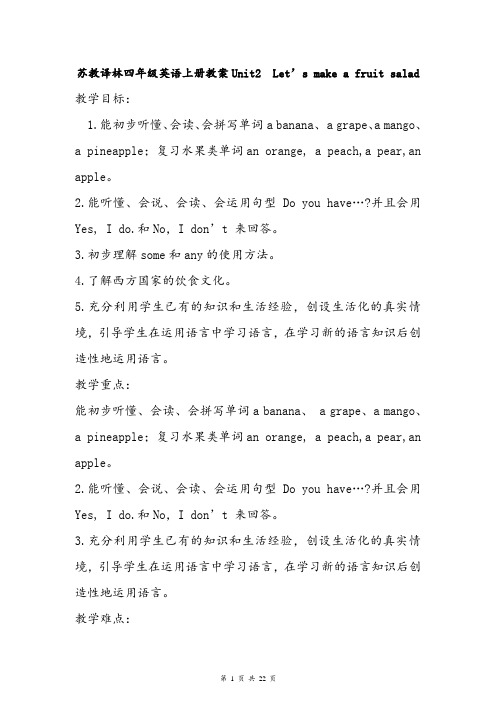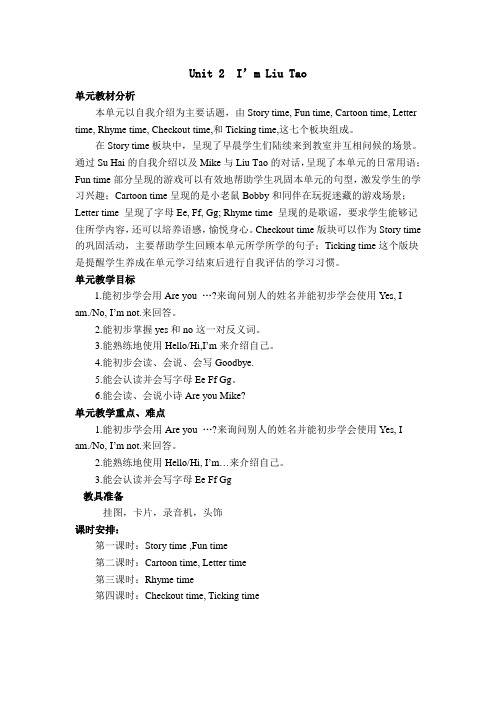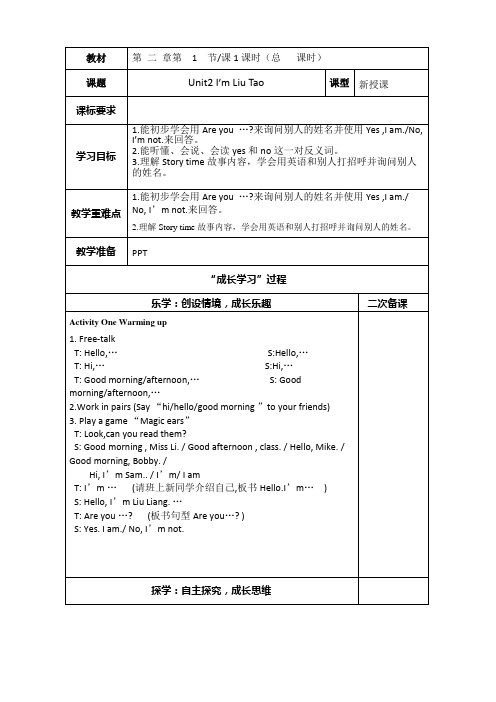译林版四年级上册第二单元教案
- 格式:doc
- 大小:151.50 KB
- 文档页数:14

教案:Unit 2 Let’s make a fruit salad 年级:四年级教材:译林版(三起)教学目标:1. 能够听懂、会说、会读本节课的生词和重点句子。
2. 能够用英语简单描述自己喜欢的水果和制作水果沙拉的过程。
3. 培养学生的团队合作意识和动手操作能力。
教学内容:1. 学习本节课的生词和重点句子。
2. 学习如何制作水果沙拉的步骤。
3. 进行小组合作,制作水果沙拉。
教学重点与难点:1. 重点:本节课的生词和重点句子,如何用英语描述水果和制作过程。
2. 难点:如何正确发音生词和句子,如何进行小组合作制作水果沙拉。
教具与学具准备:1. 教具:多媒体课件、水果沙拉的食材、厨房用具。
2. 学具:学生自带水果、笔记本、彩色笔。
教学过程:Step 1: 热身(5分钟)1. 教师与学生用英语进行简单的问候,引导学生用英语进行自我介绍。
2. 教师播放一首与水果相关的英语歌曲,引导学生跟着歌曲一起唱。
Step 2: 导入(10分钟)1. 教师出示一些水果的图片,引导学生用英语说出水果的名称。
2. 教师提问学生喜欢的水果,引导学生用英语进行回答。
Step 3: 新课呈现(15分钟)1. 教师出示本节课的生词和重点句子,引导学生跟读并模仿。
2. 教师通过PPT展示如何制作水果沙拉的步骤,引导学生用英语进行描述。
Step 4: 小组合作(10分钟)1. 教师将学生分成小组,每组学生用自己的水果和厨房用具制作水果沙拉。
2. 教师引导学生用英语描述制作水果沙拉的过程,并进行记录。
Step 5: 展示与评价(5分钟)1. 每个小组将自己的水果沙拉和制作过程展示给其他同学。
板书设计:1. 本节课的生词和重点句子。
2. 如何制作水果沙拉的步骤。
作业设计:1. 抄写本节课的生词和重点句子。
2. 用英语写一篇关于制作水果沙拉的短文。
课后反思:本节课通过引导学生用英语描述自己喜欢的水果和制作水果沙拉的过程,培养了学生的英语表达能力和团队合作意识。

苏教译林四年级英语上册教案Unit2 Let’s make a fruit salad 教学目标:1.能初步听懂、会读、会拼写单词a banana、 a grape、a mango、a pineapple;复习水果类单词an orange, a peach,a pear,an apple。
2.能听懂、会说、会读、会运用句型Do you have…?并且会用Yes, I do.和No,I don’t 来回答。
3.初步理解some和any的使用方法。
4.了解西方国家的饮食文化。
5.充分利用学生已有的知识和生活经验,创设生活化的真实情境,引导学生在运用语言中学习语言,在学习新的语言知识后创造性地运用语言。
教学重点:能初步听懂、会读、会拼写单词a banana、 a grape、a mango、a pineapple;复习水果类单词an orange, a peach,a pear,an apple。
2.能听懂、会说、会读、会运用句型Do you have…?并且会用Yes, I do.和No,I don’t 来回答。
3.充分利用学生已有的知识和生活经验,创设生活化的真实情境,引导学生在运用语言中学习语言,在学习新的语言知识后创造性地运用语言。
教学难点:1. 初步理解some和any的使用方法。
教学疑点学生能否理解some和any的使用方法,渗透的语法知识能否完全掌握?教学准备:挂图,卡片,多媒体(PPT),学生自带水果,老师做的水果沙拉教学过程:Step 1 Greeting and warm up1.GreetingT: Hello, boys and girls. How are you ?S: I’m fine, thank you. And you?T: I’m well.2.Warm upPlay a game----Fast response游戏规则:快速闪现问题,抢答例如:What can you see?I like monkeys, What do you like ?Do you like monkeys ?What colour is the …?Step 2 Presentation1.Play a game----Magic bag游戏规则:收口的口袋里装些玩具和水果。

译林英语四年级上册第二单元(第1课时)教学设计一、教学目标:1. 语言技能目标:a. 学会认读生词hotel,room,key,card,welcome等,并能按照提示正确拼写单词;b. 能够听懂并模仿短语welcome to,Do you have a room for me?这两个句型,并在实际情境中运用;c. 理解掌握日常会话中常用的语言表达方式,如问候、提问、请求、感谢等。
2. 学科素养目标:a. 能够从图画中获取信息、推理,培养观察力与想象力;b. 通过构建语言情境,引导学生阐释文化差异,理解并尊重多元文化。
二、教学过程设计:1. Warming-up (5分钟)师生互相问候,以开放式问题引导学生展开短暂而轻松的闲聊。
例如:What's your name? How are you today? Do you like English?2. Presentation (20分钟)a. 通过生动的图片和语音素材,教授新单词hotel,room,key,card,welcome等,并注重鼓励学生多次模仿。
b. 介绍“入住酒店”这一常见场景,并展示酒店前台的相关图片,让学生通过图片感受到酒店大堂的奢华和热闹。
c. 提问What will you say when you enter a hotel?,引导学生说出自己的答案,并在此基础上展示模板句型——Welcome to [hotel name]。
d. 提供一组图片,要求学生根据图片和短语Do you have a room for me?的提示,想象自己和酒店前台进行对话。
e. 教授新单词single room和double room,学生通过观察图片的差异,理解它们的不同含义。
3. Practice (15分钟)a. 运用角色扮演方式,模拟“入住酒店”的情景。
学生分成两组,一组扮演酒店前台,一组是旅客。
旅客在各自的短语卡片上选择合适的语句进行表达,前台需用英语回答。

Unit 2 I’m Liu Tao单元教材分析本单元以自我介绍为主要话题,由Story time, Fun time, Cartoon time, Letter time, Rhyme time, Checkout time,和Ticking time,这七个板块组成。
在Story time板块中,呈现了早晨学生们陆续来到教室并互相问候的场景。
通过Su Hai的自我介绍以及Mike与Liu Tao的对话,呈现了本单元的日常用语;Fun time部分呈现的游戏可以有效地帮助学生巩固本单元的句型,激发学生的学习兴趣;Cartoon time呈现的是小老鼠Bobby和同伴在玩捉迷藏的游戏场景;Letter time 呈现了字母Ee, Ff, Gg; Rhyme time 呈现的是歌谣,要求学生能够记住所学内容,还可以培养语感,愉悦身心。
Checkout time版块可以作为Story time 的巩固活动,主要帮助学生回顾本单元所学所学的句子;Ticking time这个版块是提醒学生养成在单元学习结束后进行自我评估的学习习惯。
单元教学目标1.能初步学会用Are you …?来询问别人的姓名并能初步学会使用Yes, I am./No, I’m not.来回答。
2.能初步掌握yes和no这一对反义词。
3.能熟练地使用Hello/Hi,I’m来介绍自己。
4.能初步会读、会说、会写Goodbye.5.能会认读并会写字母Ee Ff Gg。
6.能会读、会说小诗Are you Mike?单元教学重点、难点1.能初步学会用Are you …?来询问别人的姓名并能初步学会使用Yes, I am./No, I’m not.来回答。
2.能熟练地使用Hello/Hi, I’m…来介绍自己。
3.能会认读并会写字母Ee Ff Gg教具准备挂图,卡片,录音机,头饰课时安排:第一课时:Story time ,Fun time第二课时:Cartoon time, Letter time第三课时:Rhyme time第四课时:Checkout time, Ticking time(Period 1)一、教学内容:Unit 2 Story time ,Fun time二、教学目标:1.能初步学会用Are you …?来询问别人的姓名并能初步学会使用Yes, I am./No, I’m not.来回答。

Activity Two Presentation and practice1. Play a game “Choose and guess”T: Look, who is she? (出示人物图片)S: Yang Ling.Ss: Hello, Yang Ling. (复习第一课已学的人名:Mike,Su Hai,Liu Tao, Miss Li )T: Now let’s play a game. Who’d like to come to the front?S1: Me.T: Choose one. Who can guess who she is? You may ask “Are you…?”.S2: Are you Su Hai ?S1: Yes, I am. (老师可以玩三四次这个游戏,猜到的可以为小组赢得一颗星)2.Watch the cartoon and find the characters. ( 看动画,找出文中出现的人物。
)T: Let’s watch a cartoon and find the characters in the story.S: Liu Tao, Mike, Su Hai, Yang Ling.3. Read and choose( ) 1. --Are you Su Hai?--___________.A. Yes, I am.B. No, I am.C. No, I’m not. ( ) 2. --Are you Wang Bing?--___________.A. Yes, I am.B. No, I’m not. I’m Liu Tao.C. Yes, I’m not.4. Read after the tape.5.Play in roles.6.Act the story.善学:善用方法,成长能力Step 3 Consolidation1.Play a game——Fun time(Guess and say)游戏规则:学生1站在讲台前,坐在位置上的一个学生2站起来说Hello.2.Say a chantHi, hi. Are you Su Hai?No, no, I’m not.Hi, hi. Are you Yang Ling?Yes, yes, I am.Step 3 Consolidation1.Make a chantHi, hi, are you Yang Ling ?Yes, yes, you are right.Hi, hi, are you Wang Bing ?No, no, I’m Liu Tao.2.Review letters “Aa-Dd.”3.Learn the new letters “ Ee-Ff Gg ”教师延续上一习题Dd,让学生思考,引出Ee,并且在黑板上示范。

译林版四年级英语上册第二单元教案译林版四年级英语上册第二单元教案精选2篇(一)Title: Unit 2 - My Classroom and My SchoolObjectives:1. To introduce vocabulary related to the classroom and school.2. To practice using the vocabulary in sentences and conversations.3. To develop listening and speaking skills through activities and discussions.4. To enhance reading and writing skills through short texts and writing exercises.Materials:- Textbook: Shulingban English, Grade 4, Unit 2- Whiteboard or blackboard and markers/chalk- Flashcards with pictures of classroom/school objects- Worksheets and handouts with activitiesWarm-up:1. Greet the students and review the vocabulary from the previous unit.2. Ask questions to stimulate discussion about their classrooms and schools. For example:- What is your classroom like?- What objects can you find in your classroom?- What do you like about your school?Presentation:1. Introduce and elicit vocabulary related to the classroom and school using flashcards and real objects. Write the words on the board and explain their meanings.2. Create sentences and ask students to repeat after you. For example:- This is a desk. (Point to a picture of a desk)- That is a chair. (Point to a picture of a chair)Practice:1. Divide the class into pairs or small groups.2. Give each group a set of flashcards or pictures of classroom/school objects.3. Ask each group to arrange the flashcards in different ways, such as by category(e.g., furniture, stationery) or by size (e.g., big, small).4. In rotations, have groups present their arrangements and describe them using the target vocabulary. Encourage students to use complete sentences.5. Monitor and provide guidance as needed.Listening:1. Play a recording of a short conversation about a classroom or school.2. Ask students to listen and answer questions related to the conversation.3. Play the recording again if necessary.4. Discuss the answers as a class.Reading:1. Provide short texts about a classroom or school.2. Ask students to read the texts individually or in pairs.3. Have a class discussion about the texts, focusing on comprehension and key details.4. Ask comprehension questions to check understanding.Writing:1. Provide worksheets with exercises to practice writing sentences using the target vocabulary.2. Have students complete the exercises individually or in pairs.3. Review and discuss the answers as a class.Homework:1. Assign writing tasks where students describe their classrooms or schools using the target vocabulary.2. Encourage students to use complete sentences and include as many details as possible.Assessment:1. Observe and assess students' participation and comprehension during class discussions and activities.2. Review completed worksheets and writing assignments for accuracy and understanding.Notes:- Adapt the lesson plan according to the needs and abilities of the students.- Include additional activities and games to make the lesson more interactive and engaging.- Provide extra support for struggling students and challenge the advanced learners with additional tasks.译林版四年级英语上册第二单元教案精选2篇(二)Unit 1: HelloLesson 1: Greeting and IntroductionsObjectives:- Students will be able to greet and introduce themselves in English.- Students will be able to ask and answer simple questions about personal information.Materials:- Greeting cards with different expressions (e.g. hello, hi, good morning, etc.)- Flashcards of people with names on them- Pictures of different daily activities (e.g. eat, play, sleep, etc.)Procedure:1. Warm-up (5 minutes)- Greet the students with different expressions (e.g. hello, hi, good morning, etc.) and ask them how they are doing.- Ask some students to greet the class using different expressions.2. Introduction (10 minutes)- Show the flashcards of people with names on them. Ask the students to name the people on the flashcards.- Introduce yourself using the flashcards (e.g. Hello, my name is Mark).- Have the students repeat after you and introduce themselves using the flashcards (e.g. Hello, my name is Sarah).3. Vocabulary (15 minutes)- Show the pictures of different daily activities.- Teach and practice the vocabulary words for each activity.- Have the students repeat the words after you and practice using them in sentences (e.g. I eat breakfast in the morning).4. Pair Work (15 minutes)- Divide the class into pairs.- Give each pair a set of greeting cards.- In their pairs, students will take turns choosing a greeting card and using it to greet their partner. They will then introduce themselves and ask and answer questions about their daily activities.5. Group Activity (15 minutes)- Divide the class into larger groups.- Give each group a set of flashcards and pictures of daily activities.- In their groups, students will take turns picking a flashcard and a picture. They will then introduce the person on the flashcard and tell the group what activity they do (e.g. This is Sarah. She eats breakfast in the morning).6. Wrap-up (5 minutes)- Review the vocabulary and expressions learned in the lesson.- Ask students to share one thing they learned about a classmate during the pair and group activities.Assessment:- Observe students' participation and ability to greet and introduce themselves.- Listen for correct pronunciation and usage of vocabulary words.- Monitor students' ability to ask and answer questions about personal information.。
译林版英语四年级上册Unit 2 Let’s make a fruit salad教案一、教材简析:本单元由Story time, Fun time, Cartoon time, Sound time, Rhyme time, Checkout time, Ticking time七个部分组成。
安排了“说明自己有某物”、“询问他人是否有某物”这两个语言情景,话题贴近生活,学生乐意学习。
在教学内容方面,本单元要求能听懂、会说、会读和会拼写单词a banana, a grape, a mango, a pineapple.能听懂、会说、会读和会写句型Do you have…? Yes, I do. / No, I don’t. I have….因此,对单词的字体、书写方法、规格等方面要进行示范、指导,使学生逐步形成良好的书写习惯。
二、教学目的:1.能听得懂、会说、会读和会拼写单词a banana, a grape, a mango, a pineapple. 2.能听懂、会说和会读日常交际用语3.能听懂、会说、会读、会写句型Do you have…? Yes, I do. / No, I don’t. I have…4.了辅音字母h 在单词中的读音。
6.能诵读歌谣Purple grapes.三、教学重点:1、能听得懂、会说、会读和会拼写单词a banana, a grape, a mango, a pineapple.2、能听懂、会说、会读、会写句型Do you have…? Yes, I do. / No, I don’t. I have….3、了辅音字母h 在单词中的读音。
四、教学难点:1、能听得懂、会说、会读和会拼写单词a banana, a grape, a mango, a pineapple.2、能听懂、会说、会读、会写句型Do you have…? Yes, I do. / No, I don’t. I have….五、课时安排:本单元共安排5课时Story time 1课时Fun time, Rhyme time及新单词1课时Cartoon time, Sound time及课课练1课时Checkout time, Ticking time及补充习题. 1课时复习本单元中单词、句型、做听读训练。
译林版英语四年级上册U n i t2教案怀文小学教案专用纸Step 1. Greeting and warming up.T:Nice to see you.S: Nice to see you too.T: Let’s enjoy our English lessons now. Let’s sing a song, OK? Follow me(加动作):Apple treeStep 2.Presentation.1.Free talk:T:Do you know the name of the song? It’s appletree. Do you like apples?S:Yes,I do.(用Unit1的句型复习已学水果单词)2.出示标题。
Apples, pears and oranges are all fruit.Let’s make a fruit salad.Step3. Watch the cartoon.1.Watch and answer: What fruit can you see ?S: I can see a /an/ some…教授单词:banana ,grape, mango, pineapple, fruit. T:I have a/an…(老师出示单词卡或实物). Do you have a banana/grape/mango/pineapple?S:Yes,I do. /No, I don’t.2.Practice先师生问答,再学生分组操练。
T:Do you have …?S:Yes, I do.No, I don’t.板书句型。
让学生发现此句型与第一单元句型的异同之处。
总结Do you…?的回答用语。
Step 4. Reading time1.Read and say.快速阅读课文,身处课文,说说每个人有什么水果。
I’m…I have…2.学生逐图跟读,提醒注意模仿语音语调。
4A英语科第二单元教学计划
课题:Unit 2 Let’s make a fruit salad 上课时间:总6课时第1课时
课题:Unit 2 Let’s make a fruit salad 上课时间:总6课时第2课时
教学目标1.能熟练地听懂、会读、会拼写单词a banana、a grape、a mango、a pineapple;复习水果类单词an orange, a peach,a pear,an apple。
2.能熟练地听懂、会说、会读、会运用句型Do you have…?并且会用Yes, I do.和No,I don’t 来回答。
3.能初步会用How many…?询问可数名词的数量。
4.复习数字1-12
教学重难点1.能熟练地听懂、会说、会读、会运用句型Do you have…?并且会用Yes, I do.和No,I don’t 来回答。
2.能初步会用How many…?询问可数名词的数量。
教具
学具
挂图,卡片
教学过程诊断调整Step 1 Greeting and warm up
1.Dictation
2.Warm up
(1)Question box
教师出示一个盒子----Question box,盒子里装了过去所学的问题,让
学生在盒子一抽出一张纸回答问题。
例如:What’s this? What colo ur is it?
I have a pencil. Do you have a pencil?
Do you like tigers?
I like apples. What do you like? …
Step 2 Presentation
1.Fun time
(1)Drawing time
教师出示Fun time 的光盘内容----Draw pictures
出示教师所画的图片,做示范,让学生快速简笔画
(2)Speaking time
对话练习
A:Do you have a book? B: Yes, I do. Do you have any apples?
A: No, I don’t.Do you have any bananas?B: Yes, I do.
(2)Showing time
A: I have…(I don’t have…)B: I have…(I don’t have…)
2.Review Story time
A.自己单独读
B.跟伙伴扮演角色读
C.跟伙伴齐读
课题:Unit 2 Let’s make a fruit salad 上课时间:总6课时第3课时
课题:Unit 2 Let’s make a fruit salad 上课时间:总6课时第4课时
教学目标1.能熟练听懂、会读、会拼写本单元单词。
2.能熟练听懂、会说、会读、会运用本单元句型。
3.能熟练会唱本单元歌曲:Do you like purple grapes?
4.能明白字母Hh在单词中的发音/h/,能总结归纳过去所学单词
5.完成补充习题全部练习以及同步探究的部分练习
教学重难点1.能熟练听懂、会读、会拼写本单元单词。
2.能熟练听懂、会说、会读、会运用本单元句型。
3.能熟练会唱本单元歌曲:Do you like purple grapes?
4.能明白字母Hh在单词中的发音/h/,能总结归纳过去所学单词
教具
学具
挂图,卡片
教学过程诊断调整Step 1 Greeting
1.Greeting
2.Dictation
3.Sing a song
Step 2 Play a game----Perfect artist
游戏规则:老师出示一些基础形状,让学生在此基础上画各种东西,
涂上颜色。
最后展示,让其他同学猜是什么。
S1:Do you have a/an…?
S2: Yes, I do./No, I don’t.
Step 3 Sound time
1.出示图片
T:Who’s this girl? Let’s listen to Sound time.
S: She’s Helen.
2.出示Helen Hh /h/
教读Hh ,个人读,小组读
3.归纳Hh 发音
behind have horse hot hurry he Helen
4.Sound time
出示Sound time 句子。
学生比较喜欢这样的环节,尤其是当老师配上动作的时候,更是激起
了学生的表现欲。
have 吃组词:have breakfast/lunch/diner
回忆以前的课文:
课题:Unit 2 Let’s make a fruit salad 上课时间:总6课时第5课时
课题:Unit 2 Let’s make a fruit salad 上课时间:总6课时第6课时
Unit 2 Let’s make a fruit salad
单元教学反思
本单元教学目标是让学生掌握四种新的水果类单词以及句型“Do you have...? ”的问答。
在这节课中我采用了情景教学,让学生自主学习与合作学习。
让学生利用自己手中的水果实物和在卡纸上画的简笔画理解学习新句型。
因为利用到实物和学生动手,同学们积极性很高。
但在表演过程中对Do you have...?和Unit1 的句型Do you like...?老是说混淆,但在写的过程中基本没有出现这种错误,所以应在以后的课时中加强对新句型说的操练。
在这单元一开始我对本单元的四会句型和单词进行了听写。
从检查的结果来看学生掌握水平严重参差不齐。
从小学英语从四年级上册开始,除了要求学生能够默写四会单词外,还增加了一些四会句型。
这个要求使四年级的学生一下子觉得有点不大适应,有些学生连四会单词的拼写都觉得很吃力,现在要求他们开始掌握句型的确有点吃力。
所以,怎么样帮助他们掌握这些句型,成了这学期的重要任务。
所以我准备在教授句型时先当堂在抄写本上进行适量的抄写,默写,翻译,及时批改,对拼写错误的和格式错误的学生进行个别指导,努力做到人人都能掌握。